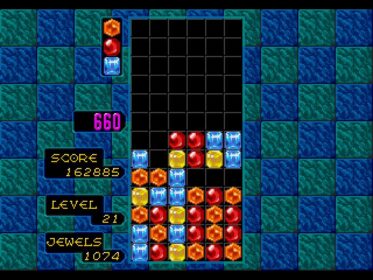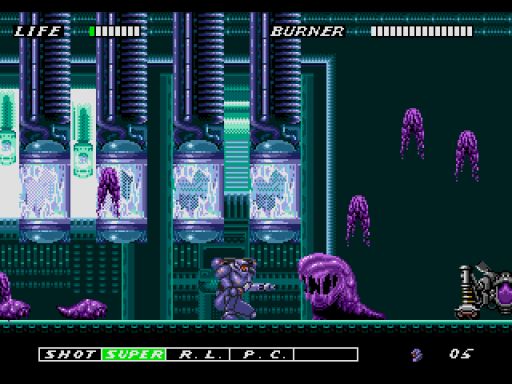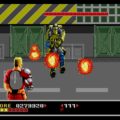Developer: Sega Publisher: Sega Release: 09/90 Genre: Puzzle
During the 16-bit era there was a bitter war raging between Sega and Nintendo fans. This conflict threatened to destroy playgrounds across America if it did not stop. What am I talking about? I am talking about the war between Tetris and Columns fans. What, did you think I meant Sonic vs. Mario? I kid, I kid. With Nintendo locking up the Tetris rights Sega wisely licensed Columns for the arcade and home. While not quite the phenomenon as the infamous line crusher Columns is a solid alternative.
I do not think it is a stretch to say for many like myself Columns was their first match three game. My initial exposure to the game actually came from the Game Gear version which I am still fond of today. Its Genesis counterpart is a port of the arcade game and just as good if not better thanks to its easily accessible multiplayer mode. Although Tetris is still my go to game when it comes to puzzle titles that is not a knock against Columns. It just means the competition is that strong.
While the rules of match three puzzle games are ubiquitous at this point Columns was one of the first. Columns of three different colored gems fall into the playing field slowly before resting at its bottom. While it is falling you can cycle the position of the jewels to make better matches. Even when it rests on the bottom or on top of another piece you have a few seconds to cycle before it is locked in. When three or more of the same color/symbol connect they disappear. From any remaining jewels will fall and potentially create further matches. Matches can be made horizontally, vertically, and diagonally which creates a unique dynamic when setting up your pieces.
Columns has a different feel to other puzzle games which gives it its own vibe. Because you are only matching three or more jewels at a time it is quicker and more relaxed. The fear of not receiving the right piece does not exist since matches are easier and faster to create. There are less color combinations to keep track of as well. Even blindly setting up matches will lead to combos that create the dopamine rush that craves more. This version is a bit bare compared to what the match three genre would evolve into but no less fun.
If you play the game as straightforward as possible it is incredibly boring. Personally I like seeing entire lines clear compared to individual blocks of 3-5. You can easily keep the field clear up until the higher levels but your score will not be as impressive. Taking advantage of score multipliers is the way to go to rack up the most amounts of points. Diagonal matches award the most points as well as four and five point blocks, which give double or triple. These are trickier to setup but worth it. What I also like is that because of the three directional combinations cascading blocks are often unintentional but also easy to setup. Watching half of the field disappear from one combo is satisfying on the level of getting a Tetris. The ease of this occurring is also part of the charm of Columns.
The pace of the game is another point in the game’s favor. New levels come every fifty blocks cleared. That means it is a bit slower but leaves more room for planning. The speed of each subsequent level also differs wildly as it is not completely linear. For the most part the game speed increases with every level. But some are not as dramatic as others, at least to my eyes. The ramp up is slower compared to Tetris and allowed me to play longer than I expected. I freely admit I am no Tetris expert; by level 15 or 16 I tap out as the game is too quick for my hobbled reflexes. Here I have gone as high as level 29 before it becomes too much. I haven’t revisited this game in well over two decades so it was nice to see that my skills were still there.
The Genesis version of Columns has a few extra modes over its arcade parent. Most of these are geared toward making you a better player whether intentional or not. Flash Columns is for those that like an end goal in their gameplay. Here you must reach and eliminate the flashing jewel somewhere in the pile. There are options to reduce or increase the amount of starting clutter and with a strict time limit you will inadvertently become better to reach the goal. Time Trial is self-explanatory and there is a versus mode as well. So while I may not like the core gameplay as much as Tetris the game is at least feature complete.
In Closing
Columns is a solid game that is easily accessible and is welcoming to players of all skill levels. It is not as pick and play friendly as Tetris but just as addicting in the right hands. The genre may have advanced since this early entry but the core foundation means this is still a worthwhile endeavor.






